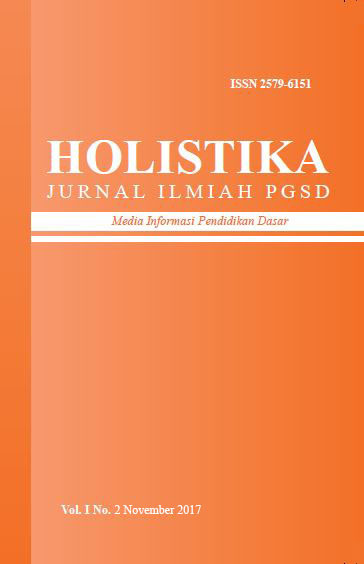PENGARUH PEMBELAJARAN AFEKTIF TERHADAP SIKAP HORMAT SISWA KEPADA GURU
DOI:
https://doi.org/10.24853/holistika.1.2.%25pAbstrak
The writing of this thesis is motivated by the decrease of students’ respect attitude to the teacher, therefore, the researcher is moved to examine the causes of the decreasing respect attitude while proposing the solution by applying affective learning. The purpose of this study is to examine the differences in respect between students who use affective learning with students who do not use affective learning. The method used is quantitative method in the form of quasi experiment by using class experiment and class control with the hypothesis that there are differences of respect attitude between students who do not use affective learning. The results showed that there were differences between students using affective learning with students who did not use affective learning, it is proven from the results of t-test calculation on the students’ respect attitude after receiving treatment with 5% significance level obtained by Sig (2-tailed) of 0,000 and the value of Sig (2-tailed) is less than 0,05. Thus, it can be concluded that effective learning affects students’s respect attitudePenulisan skripsi ini dilatarbelakangi oleh adanya penurunan sikap hormat siswa kepada guru sehingga penulis tergerak untuk meneliti apa penyebab penurunan sikap hormat tersebut sambil mengajukan solusi menerapkan pembelajaran afektif. Tujuan penelitian ini adalah untuk meneliti tentang perbedaan sikap hormat antara siswa yang menggunakan pembelajaran afektif dengan siswa yang tidak menggunakan pembelajaran afektif. Metode yang digunakan adalah metode kuantitatif yang berbentuk percobaan semu dengan menggunakan kelas eksperimen dan kelas kontrol, dengan hipotesis terdapat perbedaan sikap hormat antara siswa yang menggunakan pembelajaran afektif dengan siswa yang tidak menggunakan pembelajaran afektif. Hasil penelitian menunjukkan bahwa terdapat perbedaan antara siswa yang menggunakan pembelajaran afektif dengan siswa yang tidak menggunakan pembelajaran afektif, hal ini terbukti dari hasil perhitungan uji-t skala sikap hormat siswa setelah mendapat perlakuan dengan taraf signifikansi 5% diperoleh nilai Sig.(2-tailed) sebesar 0,000 dan nilai Sig.(2-tailed) tersebut lebih kecil dari 0,05. Dengan demikian dapat disimpulkan bahwa pembelajaran afektif berpengaruh terhadap sikap hormat siswaReferensi
Asrori, Moh. (2008). Psikologi Pembelajaran. Jakarta: Departemen Pendidikan Nasional.
Kunandar. 2014. Penilaian Autentik (Penilaian Hasil Belajar Peserta Didik Berdasarkan Kurikulum 2013. Jakarta: PT. RAJA GRAFINDO PERSADA.
Lickona, T. (2012). Mendidik untuk Membentuk Karakter. Jakarta: Bumi Aksara.
Riduwan. (2008). Skala Pengukuran Variabel-Variabel Penelitian. Bandung: Alfabeta.
Sanjaya, W. (2013). Strategi Pembelajaran Berorientasi Standar Proses Pendidikan. Jakarta: Kencana Prenamedia Group.
Slameto. 2015. Belajar dan Faktor-Faktor yang Mempengaruhi. Jakarta: PT. Rineka Cipta.
Sugiyono. (2015). Metode Penelitian Pendidikan Pendekatan Kuantitatif, Kualitatif dan R&D. Bandung: Alfabeta.
Supriyanti. (2008). Sopan Santun dalam Pergaulan Sehari-hari. Semarang: Ghyyas Putra
Widoyoko, E.P. (2014). Penilaian Hasil Pembelajaran di Sekolah. Yogyakarta: Pustaka Pelajar.
##submission.downloads##
Diterbitkan
Terbitan
Bagian
Lisensi
Authors who publish with this journal agree to the following terms:
- Authors retain copyright and grant the journal right of first publication with the work simultaneously licensed under a Creative Commons Attribution License that allows others to share the work with an acknowledgement of the work's authorship and initial publication in this journal.
- Authors are able to enter into separate, additional contractual arrangements for the non-exclusive distribution of the journal's published version of the work (e.g., post it to an institutional repository or publish it in a book), with an acknowledgement of its initial publication in this journal.
- Authors are permitted and encouraged to post their work online (e.g., in institutional repositories or on their website) prior to and during the submission process, as it can lead to productive exchanges, as well as earlier and greater citation of published work (See The Effect of Open Access).

